Resort and Other Regional Passenger Trains
In a country where much travel is by train, it’s not too surprising that some resorts and regions catering to the tourist trade provide dedicated trains to bring people to them from the city. With the expansion of the Shinkansen network, many of these operate only over branch lines, picking passengers up from the nearest Shinkansen station. However in peak season, some trains are likely to operate from urban centers such as Tōkyō.
Note: Resort Trains operated by JR East, other than locomotive-hauled sleepers, are mainly classified as Joyful Trains (which category also includes charter trains), so this page is primarily about non-JRE resort trains operating around Tōkyō, although it also includes some JR East trains operated in conjunction with other railways. See the Loco-Hauled Trains page for the JR Blue trains (and similar JR-operated trains) and the Joyful Trains page for other trains.
Resort trains serving Tōkyō may be JR East trains, or private railroad trains, or jointly operated trains. Often they will have interior and exterior decor reflecting their purpose, and some will have specialized cars (e.g., with side facing seating or larger-than-usual windows to appreciate scenic views).
Named trains have special markers that combine the name of the train with a graphic, usually related to the name in some way. These markers are placed on the locomotive (called a headmark) or displayed on the first car (if an EMU or DMU). They may also be displayed on the rear of the last car, and painted on the sides of cars.
Izu Peninsula Trains
Izukyū 2100 (伊豆急行2100)
The Izukyū Corporation is a private railway, and subsidiary of the Tokyu Corporation, which operates the Izu Kyūkō Line to the southwest of Tōkyō. This is a 46 km line along the coast of the Izu peninsula, connecting to JR East’s portion of the Tōkaidō Main Line at Atami. This coastal region is noted for its resorts, including Onsen (hot springs inns), as well as scenic landscape. Several JR East limited express trains, including the Odoriko and Super View Odoriko, interoperate onto the Izu Kyūkō Line, and several Izukyū trains interoperate onto JR East, traveling as far as Shinjuku and Tōkyō Stations on weekends and during peak tourist season (or maybe that’s weekends during tourist season, as usual automatic translation of Japanese wikipedia pages can be a bit opaque). The R-5 set is apparently used as the Resort Odoriko train, serving both Tokyo and Shinjuku.
Note: although the Tokyu Corporation (more formally, Tōkyō Kyūkō Dentetsu Kabushiki-gaisha, or literally the Tōkyō Express Train Co., Ltd.) also operates several private railroads in its own right, the Izukyū Corporation (Izu Kyūkō Kabushiki Kaisha, or literally Izu Express Co., Ltd.) and its Izu Kyūkō Line appear to be separate from the those.
There were five 2100 series train sets operated by Izukyū (some may have been discontinued), and they are painted in at least two distinctive styles (although R-2 and R-5 aren’t quite identical). The trains are EMUs, originally operated in eight-car sets, but now truncated to seven cars. One of the sets operates as the Resort Odoriko limited express. At least some of the seating in these trains is side-facing, providing scenic views along the coastline. Sets R-4 and R-5 have design differences from the earlier models (and from each other).
In 2002, one of the sets (possibly R-2) was decorated with a flower-pattern (possibly a temporary wrap as it’s described as “flower-wrapping” in the Japanese caption), and operated as the “Fleur Odoriko” (Flower Dancer). It’s unclear if the 2006 photo of the Izu Flower Train below is this same train, or a different one (it may have been a seasonal summer train, but the translation on the Japanese Odoriko (“dancers”) wikipedia page is hard to make out).
Sets:
- R-1:(1985) Original Black Ships Train, although that is a later paint scheme
- R-2: (1986) Resort 21, a.k.a., Resort Liner 21 (in 1988)
- R-3: (1988) Also used as the “Liner Resort” (or “Resort Liner”?), it doesn’t appear in current photos, unless it’s identical to R-2 and serving the same use.
- R-4: (1990) Black Ships Train
- R-5: (1993) Alpha Resort 21 (or Resort 21 Alpha), apparently also operates/operated as Resort Odoriko
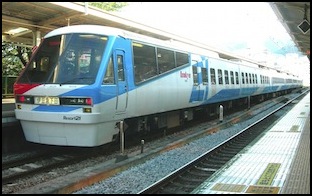
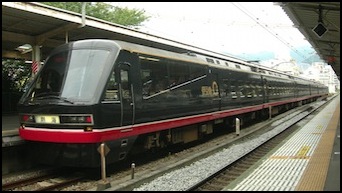
L: Izukyū 2100 R-2 Set, Resort 21 (2008), R: R-4 Set, Black Ships Train, Resort 21 EX (2008)
Photographer (both): Rsa
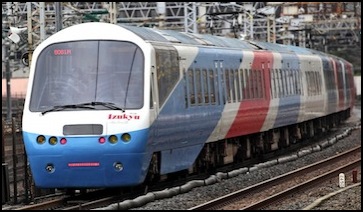
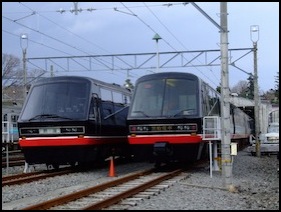
L: Izukyū 2100 R-5 Set, Alpha Resort 21 (2009), R-4 (left) and R-1 (right), note windshield difference (2006)
Photographers: Tennen-Gas, LERK
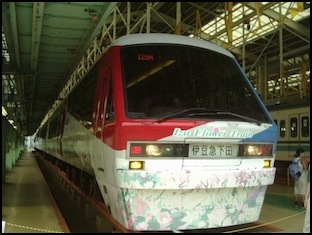
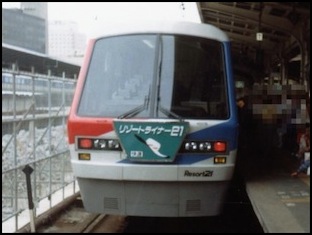
L: Izu Flower Train (2006), R: Resort Liner 21 (1988)
Photographers: Rsa, Cassiopeia Sweet
Specifications:
Type: Izukyū 2100
Built: 1985 - 1993
In use: 1985 - present
Top Speed: unknown
Power: unknown
Type: electric, 1,500 V DC catenary
Weight: unknown
Use: Passenger
Assigned: unknown
Tōhoku Region Trains
The Tōhoku region is the northern part of Japan’s main island of Honshū (the name literally means “northeast”). This region is largely mountainous, and while it does contain a number of large urban areas, much of it is rural and agricultural in nature. According to wikipedia tourism is now a major industry of the region. This area was devastated by the 2011 earthquake and subsequent failure of the Fukushima nuclear power plant, with train services disrupted throughout most of 2011, and fears over radiation have had an ongoing chilling effect on tourism.
Nikkō-Kinugawa
The Nikkō-Kinugawa (or separately Nikkō and Kinugawa) services, sometimes collectively referred to as Kinugawa, are trains jointly-operated to two important domestic-tourist destinations located in the city of Nikkō on the Tōbu Railway, originating at JR East’s Shinjuku Station.
Nikkō is the site of a large religious complex (and UNESCO World Heritage site), while Kinugawa (located in the city of Nikkō) is a hot-springs resort (Onsen). The two destinations are not adjacent, and the Kinugawa service either extends or branches off from the service to Nikkō.
JR East described (in 2010) their six-car Kinugawa service as a Limited Express, although it appears in many ways similar to a Joyful Train with a fixed route. This train operates from Tōkyō’s Shinjuku station to the Tōbu Railway’s Kinugawa line, which connects via the Tōbu Nikkō line to JR East’s Tōhoku Main Line at Omiya station (via a bypass from Tōbu Kurihashi station created in 2006 for this purpose). It makes stops only at Shinjuku, Ikebukuro, Omiya, Tōbu Nikkō and Tōbu Kinugawa stations, and primarily serves the tourist/vacation destinations at the latter two, including temples and the onsen (hot springs resorts) at Kinugawa, located about two hours north of Tōkyō. (I’m not entirely clear if the Nikkō train is the same train, or operates via a slightly different route).
The Kinugawa service was apparently begun in 2006, when the bypass was created, and both the 189 and 485 equipment was in use that year and in subsequent years (the 485, at least, was still referenced by JR East as of 2010).
485/189 Kinugawa
(a.k.a., Nikkō-Kinugawa or Nikkō and Kinugawa)
Note: The 485 and 189 trainsets described here were retired in 2010 and 2011, replaced with 253-1000 surplus equipment from the original Narita Airport Express.
The equipment displayed on JR East’s page (in 2010) was described as a 485, and has similarity to the 485-3000, except that it lacks the destination panel (a.k.a., “headmark”). The train is painted in Tōbu Railway colors, and was one of several used for the service (the others being a Tōbu Railway Series 100 train and the 189 series former Ayano Joyful Train set).
The use of multi-voltage 485 equipment for this dedicated service is a bit odd, as none of these lines have an AC-power section, so a 189 or other DC-powered model would have been sufficient. It’s likely an existing 485-3000 was re-used because it was available, although I haven’t been able to find any details on the train itself beyond photos and some descriptive text from the model produced by Kato’s Roundhouse division, which makes specialty models.
The 485 trainset was scheduled to be discontinued in April of 2011, but disruptions caused by the March 2011 Earthquake kept it in use until mid-2011.
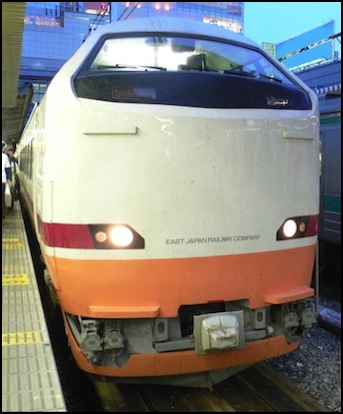
485 Kinugawa at Shinjuku Station (2006)
Photographer: Chihayasassas
There is a rather cryptic reference on the Japanese Wikipedia page for the 183/189 Series that seems to indicate that the 485 equipment was normally used on the Kinugawa service, and the former Ayano 189-based equipment (DC-powered), which isn’t as nicely outfitted, served as a replacement or peak-period supplement. The Japanese wikipedia entry on the Joyful Train page appears to say that it was used when the 485 was unavailable or when scheduling required a replacement for the usual Tobu 100 Series Spacia train, and the color scheme was the same as the 100 series. Even in Kinugawa use, the 189 was apparently referred to as the Ayano, and despite repainting into Tobu railway colors may have continued to operate as a Joyful Train when not required. I’ve seen online comments that this was scrapped in 2010, so it may have retired shortly before the 485 trainset.
The Japanese Joyful train page has a comment that suggests the 189 equipment may have had an additional function in collecting guests from Yokohama and Hachioji (in Tōkyō) stations.
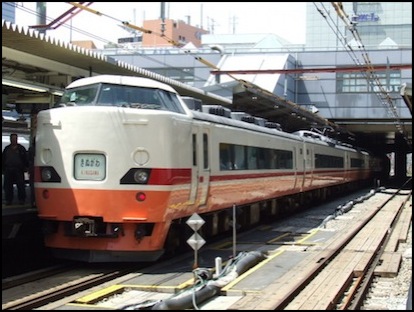
JR East "Kinugawa", 189 series at Shinjuku Station
Photographer: Lover of Romance
253-1000 Kinugawa
In July 2011, as train services rebounded after the disruptions caused by the earthquake, the older equipment was retired (due to service life limits), and replaced with two DC-power six-car 253-1000 sets (built from retired 253 series trains).
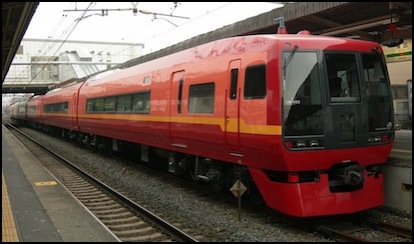
253-1000 series at Hasuda Station
Photographer: Rsa
Aizu
Aizu is a region located north of Tokyo, connected via the Ban'etsu West Line to the Tōhoku Main Line at Kōriyama (the Tōhoku Shinkansen also provides a connection at Kōriyama). JR East operates a train to there known as the Aizu (あいづ), or variations on the name (there may be more than one train operating at the same time, or the name may have changed over the years; I’m not certain).
According to Japanese wikipedia the Aizu train was an express train (via JR East’s Ban’etsu West line from Kōriyama and the Tohoku Main line) from Tōkyō’s Ueno Station. A summer version of this (or perhaps a second train) was known as the Aizu Liner (after 1992 this train may have only operated from Kōriyama to Aizu Wakamatsu, connecting to the Shinkansen at Kōriyama).
Prior to the establishment of the Shinkansen in 1992, the Aizu Liner (Aizu is sometimes translated as “Oh Idzu” for some reason) operated from Ueno Station in Tōkyō using 481 series equipment. This was abolished, probably in 1993 (but see comment below, suggesting that there is a second train), and replaced with a local train operating from Kōriyama, known as the Viva Aizu (translated by Google as the “Oh Idzu Viva”, although the name appears as “Viva Aizu” in English descriptions of models) and later the names Aizu Liner or just Aizu appear to have been used (my suspicion is that Aizu Liner and Viva Aizu are the same train, and Aizu is the express to Ueno, but I’m not certain of that).
According to one report (thanks, Lindsay), the Aizu train was a 7-car 485-1000 set in the 1990 - 1995 period, operating from Ueno to Aizu Wakamatsu via the Tohoku Main Line. A similar 9-car set was used for the Ueno - Akita Tsubasa service (which did not stop in Aizu). The Tsubasa was replaced by the Shinkansen of the same name when that began in 1992, but the Aizu service was still operating as of 1995.
As of 2012 the train was still in service, using 485 series equipment and operating from the connection to the Shinkansen line at Kōriyama. There’s a cryptic note on the Japanese Wikipedia page suggesting that a 485 series equipment formerly used for this service was being operated between Sendai and Kōriyama (possibly due to disruptions following the 2011 earthquake or perhaps it was out of service due to disruptions) and was painted in a prior “JNR express” color-scheme. However, this may refer the fact that the 485 equipment was maintained at Sendai, and that this was disrupted after the earthquake.
But the April 2012 photo below shows a 485 in the same “2005 color” scheme, which I don’t think is based on JNR. This could be a reference to the older 485 appearing in the “2009 colors” photo below (which I do believe is a JNR color scheme).
The exact relationship of these trains is unclear (to me). In particular is the question of how the Ueno-Kōriyama leg changed in 1992, when the Shinkansen was built. The 485-1000 may have begun service on the Ban’etsu West Line at this time (replacing an older Aizu Limited Express train which appears to have been a 481 Series). A JRTR article (PDF) supports this view, as does a Japanese fan site (in which case this train never operated into Tōkyō).
However, other information suggests that it may have run briefly all the way to Ueno around 2001 (see the Japanese Viva Aizu page above) and again as late as 2011. Based on the report of another Aizu running south of Kōriyama (i.e., to/from Ueno) on the Tohoku Main line, it would seem that the summer express may have been cut back to connect to the Shinkansen in 1992, while the year-round Aizu train continued to run all the way. It’s unclear if these use different equipment today, or if the summer service is just a cut-back route of the year-round service (which seems a little odd, actually, but could have been done to reduce travel times and increase Shinkansen use during the tourist season).
Sometime around 2002 the express train was apparently known as the Aizu Holiday Viva (“Oh Idzu Horidebiba”) and then changed back to Viva Aizu, before being downgraded in 2003 and renamed the Aizu Liner. If I’m reading the page right, the train was abolished in 2004 and restored (as the Limited Express “Aizu” apparently, although this could be a reference to the other train) in 2005, and in 2007 the “Aizu Liner” name appears to have been restored, at least for some trains.
There seem to have been a number of different trainsets in use, and painted in different liveries, and exactly what was used when is rather confusing (and note the cab differences on the 2007 photo described as “2005 color”, which appears to be in Tōbu railway colors, and the 2009 photo described as “2006”, which suggests the former is newer or different equipment from the latter (unless there are very different cabs on the two ends, which seems unlikely). In 2007 a 583 series train (similar to the 485) was apparently used as the Aizu Liner, in addition to the 485 used as the Limited Express Aizu. In 2008 operation was from Ueno (at least on holidays; it’s unclear if it operated on weekends also). In 2009 a “T18 485” was used (and apparently this continued into 2010, see the photo below), painted in an old JNR livery.
Note that the 2001 Viva Aizu looks a lot like the 1990 481-1500 Aizu with its headlight removed, but that the later trains appear to be different (even the “T18 485” doesn’t have quite the same rooftop headlights as the original). Also, while the 2005 version looks similar to the 2006 picture of the 189 Ayano (see the Kinugawa entry above), the headlights don’t look quite the same, and the vertical black strip isn’t present on the Ayano.
Also from 2005 a summer express train appears to have operated (the “2005 color” photo below is identified as that train), with at least some trips originating from Shinjuku, and in 2006 it may have departed from both Ueno and Shinjuku at different times. The 2005 livery appears to be Tōbu Railway colors for some reason, although there’s no reference to that railway being involved in any of these services.
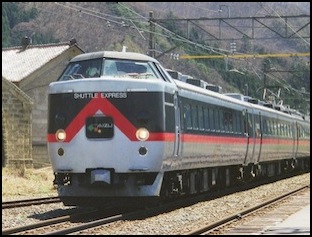
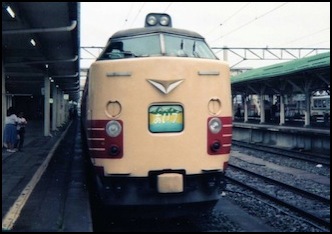
L: 485 Limited Express Viva Aizu at Kawageta Station (2001), R: 481-1500 Aizu (c. 1990)
Photographers: まも (Mamo), Cassiopeia_sweet
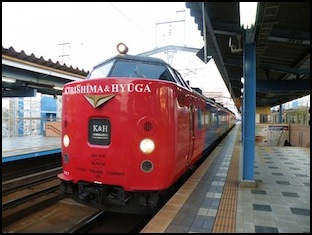
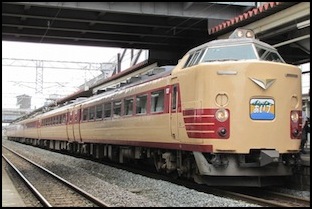
L: 485 Aizu (2006), R: “T18 485” Aizu Express in 2009 colors at Koriyama Station (2010)
Photographers: TC411-507, and 駅弁 (Ekiben)
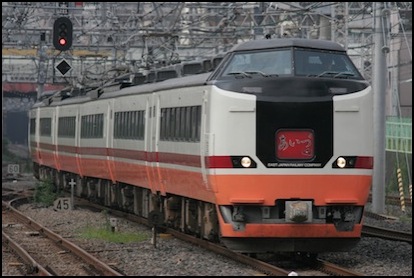
Limited Express Aizu “2005 Color” at Shinjuku Station (2007?) (original removed from wikipedia)
Photographer: Takuma333777
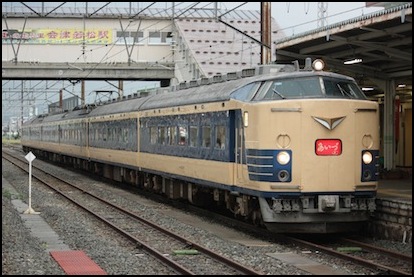
583 series EMU on an "Aizu Liner" service at Aizu-Wakamatsu Station (2008)
Photographer: Oki2_yui
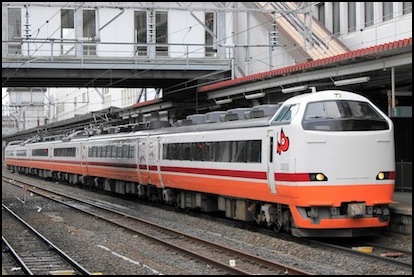
JR East 485 series Aizu Liner at Koriyama Station (2012)
Photographer: Rei Igarashi (BandaiLine)
References
Izukyū Company Train List.




